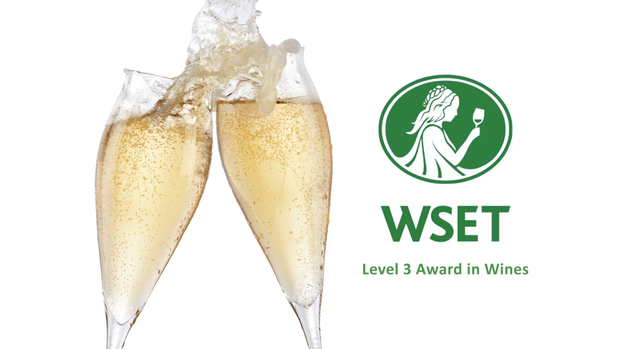“The discovery of a wine is of greater moment than the discovery of a constellation. The universe is too full of stars.” —Benjamin Franklin, circa the 1700s
Like surfing, travel writing, and fine art, a career in wine is one of the few driven by unbridled passion. You signed up for the WSET Level 3 qualification because you love wine and because you are fascinated by the story each and every bottle tells: a dashing adventure/romance that begins in the vineyards, whirlwinds through the cellars, ages gracefully in the barrel or bottle, and ends in the glass to be enjoyed with all five senses.
As you well know, however, the WSET Level 3 is no welschriesling in the park. It’s a knowledge-intensive exam that requires a lot of hard work. That's where this study guide and these certified WSET Level 3 flashcards—curated in strict accordance with the official WSET 3 textbook—make all the difference!
In this guide, I'll be walking you through all the insider tips and study hacks you can use to progress swiftly through your study materials to emerge on the other side of your prep ready to crush the final theory and tasting exam. This, together with our guide on what exam topics are covered in the WSET 3, will equip you with the intel you need to navigate the path forward.
Are you ready? Let’s do it ...
What you’ll be learning in this WSET Level 3 study guide:
- The WSET Level 3 exam: What you need to know before you start
- Top study tips for the WSET 3 exam
- Your logical approach to studying for the WSET Level 3 exam
- A final word of advice on the WSET Level 3 wine exam
How to study for the WSET Level 3 exam: what you need to know before you start
Before we dive into our best tips on how to prepare for the WSET exam more efficiently, there are a few things you’ve got to know so you can approach this challenge fully aware of what is required of you.
1. You NEED time to prepare
It’s going to take time. A lot of hours. So start your studying early and prepare to dedicate time DAILY to reviewing the material covered in class. Remember, this is not high school biology or history where you can squeak by with a few late nights of studying. Cramming almost never works: especially not for a monster of an exam like the WSET Level 3.
2. Half of the students who take the WSET 3 fail
It’s true: half of all the students who take the WSET Level 3 exam, worldwide, fail. And the top-cited reason for this is because they didn’t manage their study time appropriately. That’s it. Not because the material is too hard, or too detailed, or too much. These students simply didn’t optimize their study time.
This is where adaptive online WSET Level 3 flashcards prove to be an indispensable study tool …
3. Use Brainscape’s WSET 3 flashcards to study
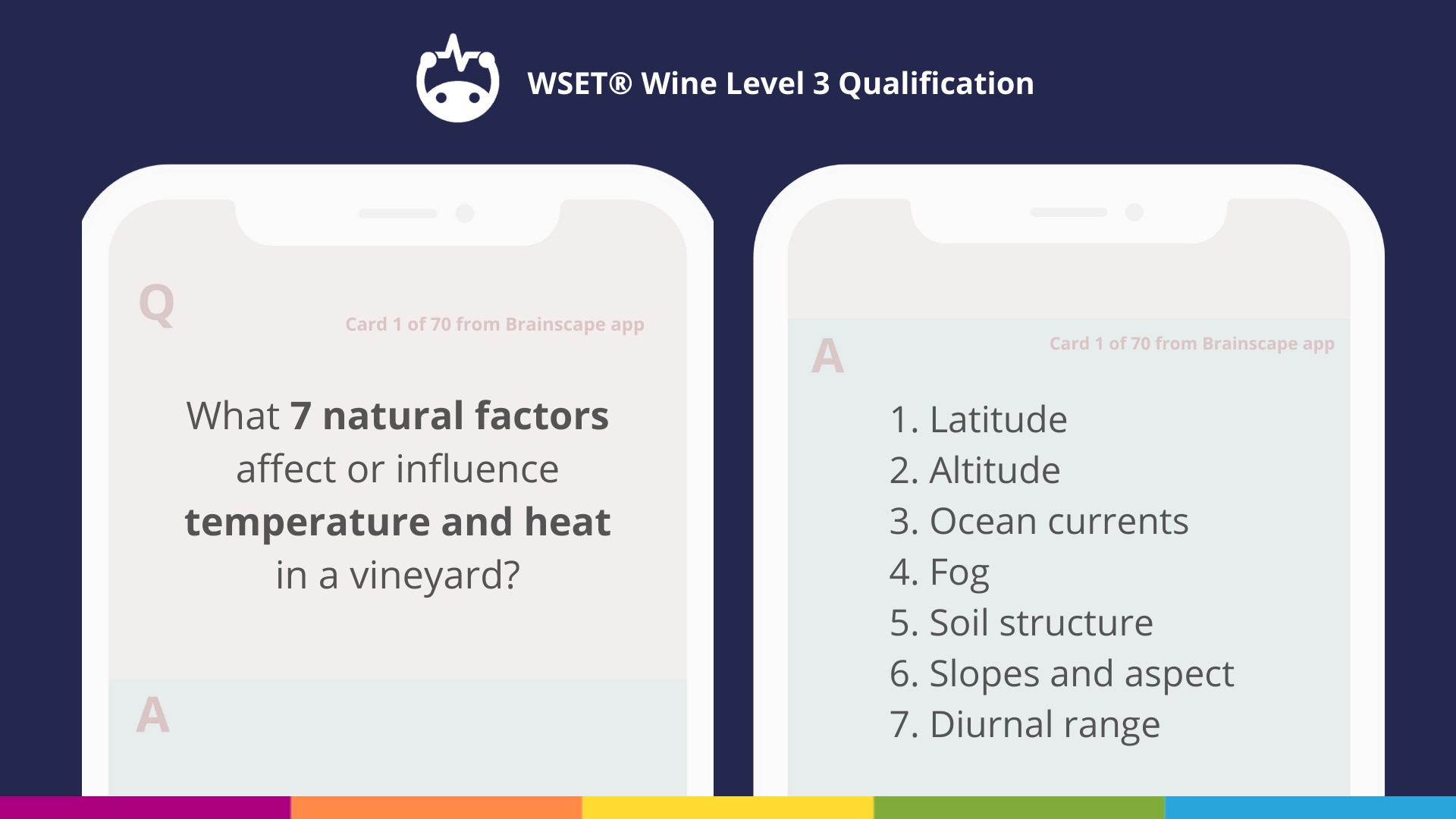
The Brainscape app leverages decades of cognitive science research to optimize your learning experience. What we mean by this is that it enables students to learn the material in HALF the time it would have otherwise taken using passive study techniques, like reading.
How does it work? (If you don't care, just skip to the next section)
Brainscape’s flashcards deliver question-and-answer pairs that engage your brain in a way that establishes deeper and more permanent memories of that information. The three ways it does this are:
Active recall
Brainscape’s flashcards compel you to recall the answers from scratch (rather than choosing an answer from a multiple-choice list). Doing this—mentally retrieving information from scratch—helps the brain remember that information for longer.
Metacognition
After viewing the answer to a question, Brainscape’s Confidence Rating tool will ask you to self-assess how well you knew the answer on a scale of 1 to 5. This compels you to ‘think about your thinking’, thereby engaging metacognition.
Spaced repetition
Based on how well you know the answer to each card, Brainscape’s intelligent spaced repetition algorithm will repeat the flashcards you don’t know that well at optimal intervals for learning. This enables you to attack your weaknesses while saving you time on reviewing the facts you already know well.
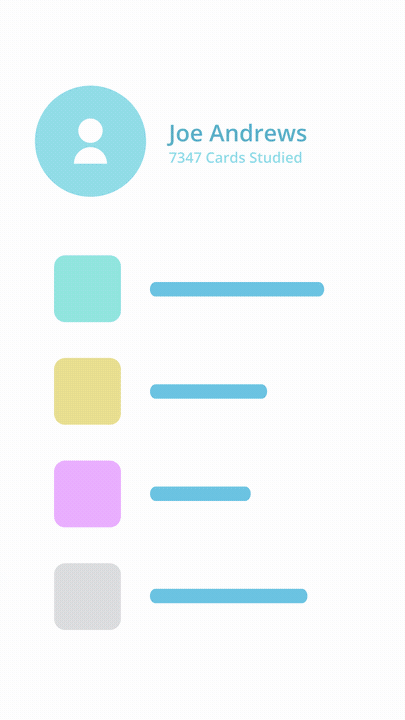
These three important cognitive science principles—active recall, metacognition, and spaced repetition—are the "secret sauce" to how Brainscape’s WSET 3 Flashcards help students really internalize and permanently onboard the information they need in order to ace their exam.
And with the world of wines waiting to be banked in your memory, this is exactly how to prepare for the WSET exam: using an efficient approach.
[By the way, if you're making your own WSET Level 3 flashcards, check out our complete guide on how to make and study flashcards.]
Top WSET 3 study tips
Tip 1: Stick to the WSET 3 textbook
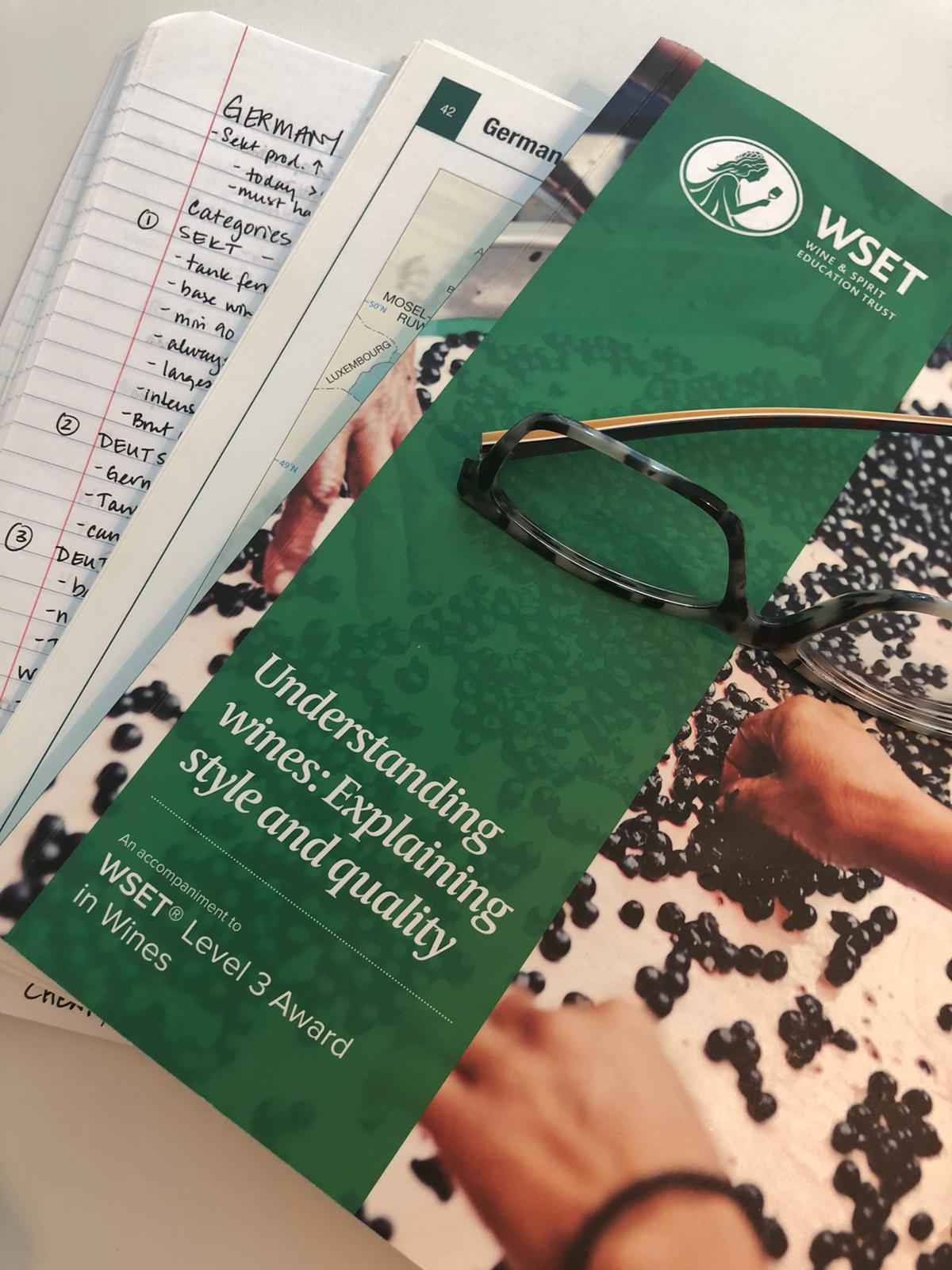
In order to study for the WSET Level 3 more efficiently, focus on the WSET 3 textbook, and always the most current edition thereof. All of the questions from the exam come from the textbook!
Pro Tip: Here and there, Brainscape's WSET flashcards go into a little more detail to flesh out the subject and perhaps provide a little more background to the facts you’re learning. This information isn’t necessarily tested in the WSET Level 3 exam but it can take you from just knowing the fact “off by heart” to understanding the why of it all.
For example you can learn that Clare Valley Rieslings tend to have more body than Eden Valley Rieslings. But if you learn why that is the case—that the Clare Valley is warmer than the Eden Valley and so its grapes get riper, developing a higher sugar content, and therefore more alcohol during fermentation—you are far more likely to remember this information.
This gives you a more holistic understanding of the subject.
Tip 2: Match the progression of your course with self study
This may be the most important of our WSET 3 study tips: start studying early.
In fact, start on day one.
That’s right: on the very first day, go home after class, read through the coursework you covered, find the relevant deck/s in Brainscape’s WSET Level 3 flashcard collection, and start permanently onboarding the facts. Then, prepare for the next lecture by studying the material before class. You can do this by:
- Reading through the relevant section in the textbook before class in order to familiarize yourself with the material,
- Identifying areas you don’t feel confident in and write down specific questions to be addressed in class,
- Using Brainscape’s WSET 3 flashcards to see what the important facts are and start memorizing and internalizing them.
In other words, when you start learning about viticulture in class, study the ‘Viticulture’ flashcards in Brainscape; when you start learning about the vinification of white wines in class, study the ‘Vinification: White Wine flashcards’ in Brainscape; and when you start learning about Northern Italy in class, study the ‘Northern Italy’ flashcards in Brainscape.
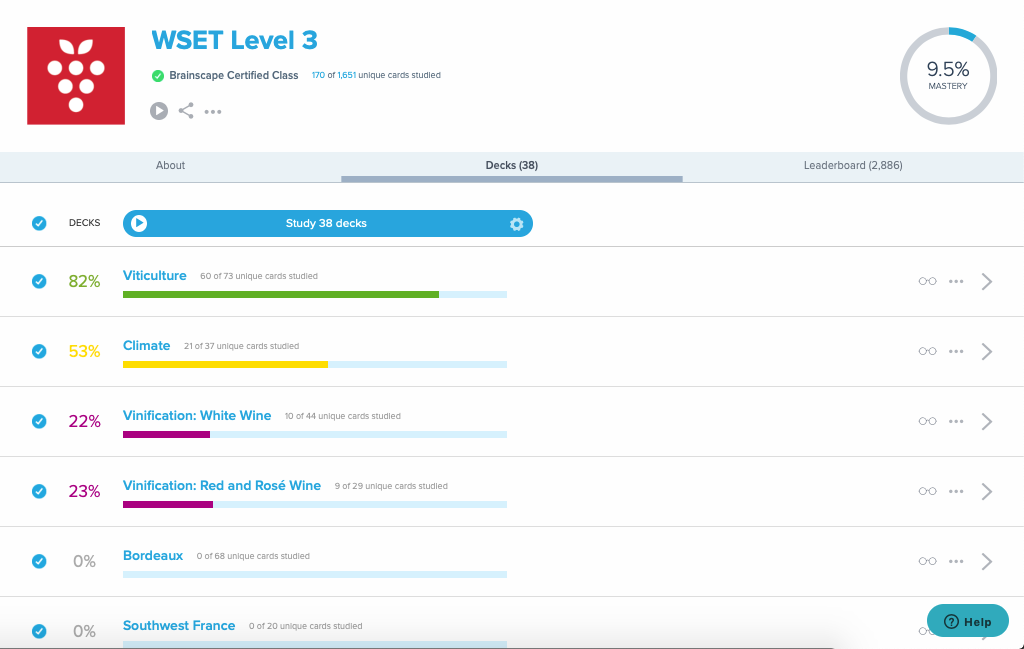
The key here is to study the same material in the flashcards soon after you’re presented with that material in class. If you do this, you can walk into class already well-versed in the course material and will be able to focus more on addressing the areas you’re unsure of.
More importantly—if you regularly practice and review your flashcards throughout the duration of your course—you will arrive at exam time having already memorized most of the important facts and information!
Tip 3: Maintain a paced study schedule
Because the WSET Level 3 exam covers so much information, the very best approach is to break the content down into small, manageable chunks and spread that learning out over the duration of the course.
The key? Make study a habit: a daily devotion of time to nurturing and growing your wine knowledge and exam preparedness.
By spending a little bit of time each and every day in the months and weeks leading up to the WSET Level 3 exam, you will chip away at the content, piece by piece, until you have internalized and memorized every last morsel of knowledge.
How many hours do I need to study for WSET exam?
The overall course is typically about 16 to 20 weeks long (four to five months), which is plenty of time to prepare for the exam if you prepare from day one. If, however, you want a more specific (and personalized) estimate of how many hours you need to study for the WSET Level 3, turn to Brainscape!
Here are two ways to space your study across this time:
(i) Calibrate your progress with Brainscape
Brainscape keeps track of your progress, using time and the ‘percentage mastery’ meter (what portion of the flashcards you know perfectly) as gauges.
As you study your WSET 3 flashcards, the app keeps track of the time it takes you. Then, every 10 flashcards, you’ll reach a checkpoint and, based on the pace you have set thus far, it will tell you how much study time you have left before you reach 100% mastery of that flashcard deck.
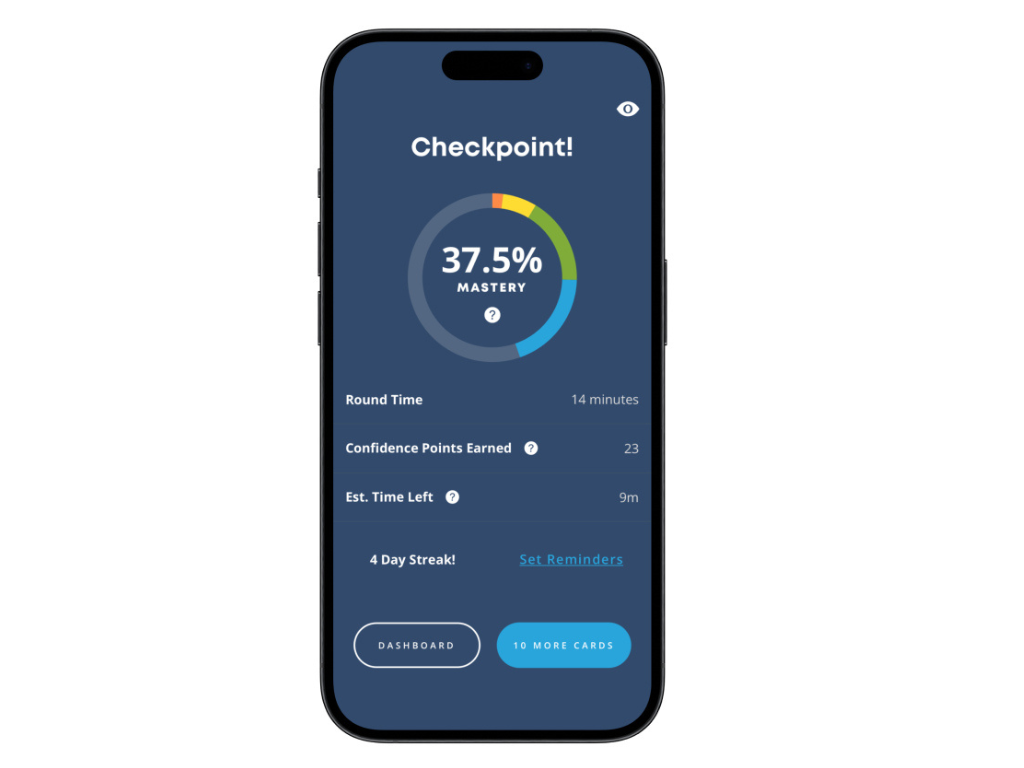
Using this Brainscape feature, you can calibrate your pace, estimating how long it should take you to complete both the flashcard deck and the entire course.
(ii) Study anywhere, anytime
Another really useful feature of Brainscape is its mobility and accessibility! Because it’s all online, you can access Brainscape’s WSET 3 program (and all that quality learning) simply by opening the app on your phone or computer, anywhere, anytime:
- 5 Minutes before your lecture
- 10 Minutes at lunch
- 20 Minutes on the bus
- 30 Minutes on the treadmill
- 15 Minutes before bed at night
By the end of the day, you can log over an hour of quality studying simply by squeezing in little flashcard study sessions here and there. Plus, your brain enjoys learning this way and tends to retain more information than it does during those long study-a-thons.
Tip 4: Don’t just learn the facts off by heart
You WILL see questions on the WSET Level 3 exam that test your understanding of the facts and how they relate to each other. So, boldly learning the facts off-by-heart, word-for-word via rote memorization (parrot fashion) will only get you so far.
For example: “Sauvignon Blanc is a grape grown on most continents in various regions and climates. Describe the characteristics and flavor profile of a Sauvignon Blanc from Sancerre versus a Sauvignon Blanc from the Napa Valley, the stylistic differences between them and why they taste the way they do.”
You won’t find the explicit answer to this question in the WSET Level 3 textbook. So right there, you’ll be stumped if you’re only focused on “the textbook answer.”
If, however, you remember the impact of climate on viticulture (e.g. cool climates = less sugar, higher acidity, and longer ripening periods | warm climate = more sugar and alcohol, bigger body), you’ll be able to construct a cogent answer by connecting the dots.
This deductive reasoning will lead you to the answer, which pivots on Sancerre being a cooler climate and Napa Valley, a warmer one.
So, while studying, bank each fact using Brainscape, and then try to use it as a building block in the formulation of answers to more complex questions. This requires you to really understand each fact and how it fits into the beautiful grand design that is winemaking and viticulture.
Tip 5: Region coupling
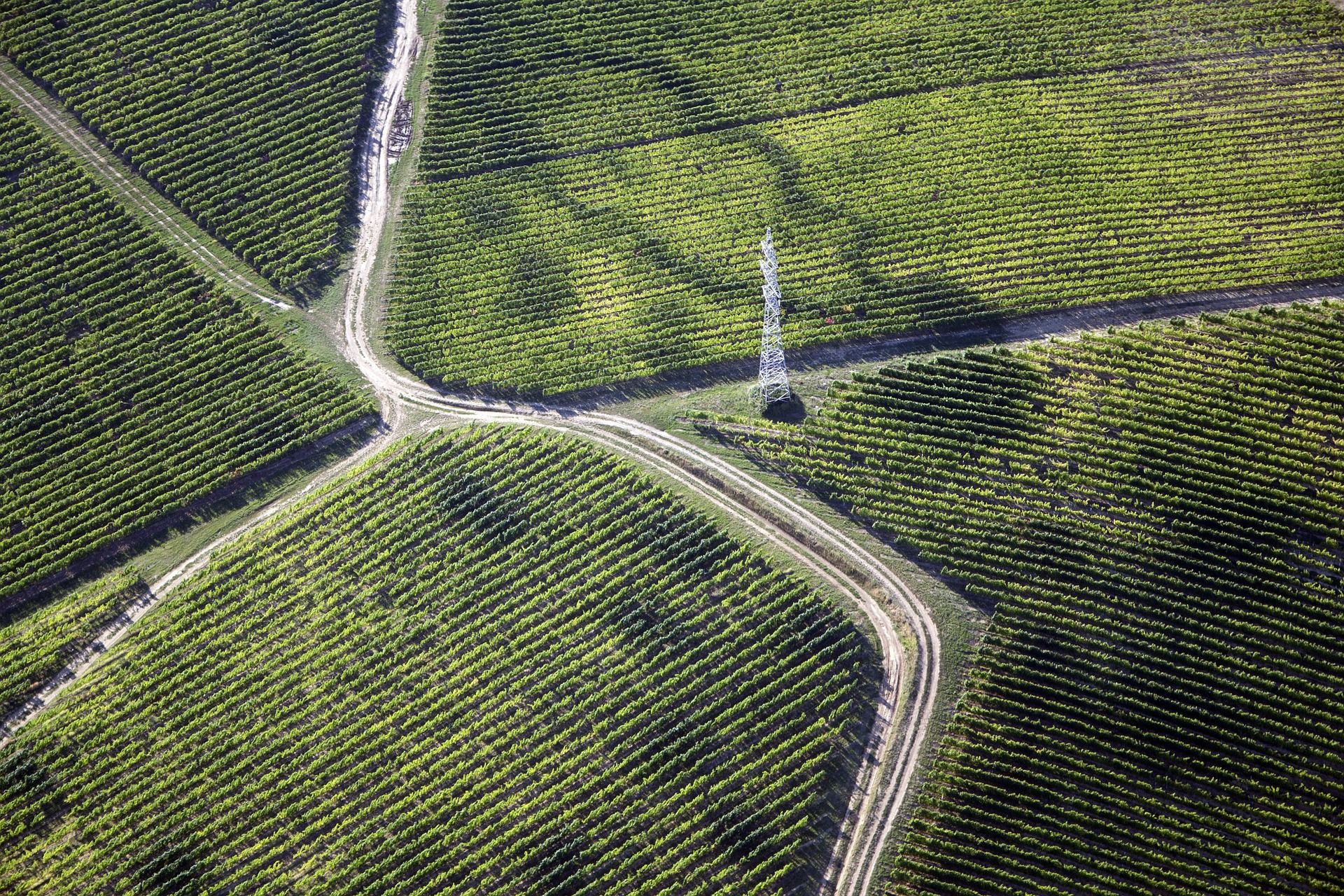
The WSET 3 exam loves to pose questions that require you to compare two different wine regions.
For example: “Explain the organoleptic differences between still Shiraz from the Barossa Valley versus still Syrah from Côte-Rôtie, discussing soil, climate, and geography.”
To answer this, you’ll need to remember everything you learned about Barossa (Australia) and Côte-Rôtie (France) as wine regions and how their terroir and climate give rise to Shiraz’s/Syrahs with different aromatic and flavor profiles.
How can you best prepare for these types of questions?
- Study two regions or appellations one after the other, paying attention to their differences and similarities (in climate, for example) and HOW these affect viticulture. This will help you understand why and how the wines these two regions produce are similar and/or different.
- Mix ‘n match Brainscape’s regional flashcard decks! Within Brainscape’s WSET Level 3 flashcards , you’ll find individual flashcard decks for every one of the regions that are tested in the WSET 3 exam. To study any two side-by-side, simply combine the regional decks you wish to study and the app will present a mix of flashcards from both regions. This will help you to study them comparatively.
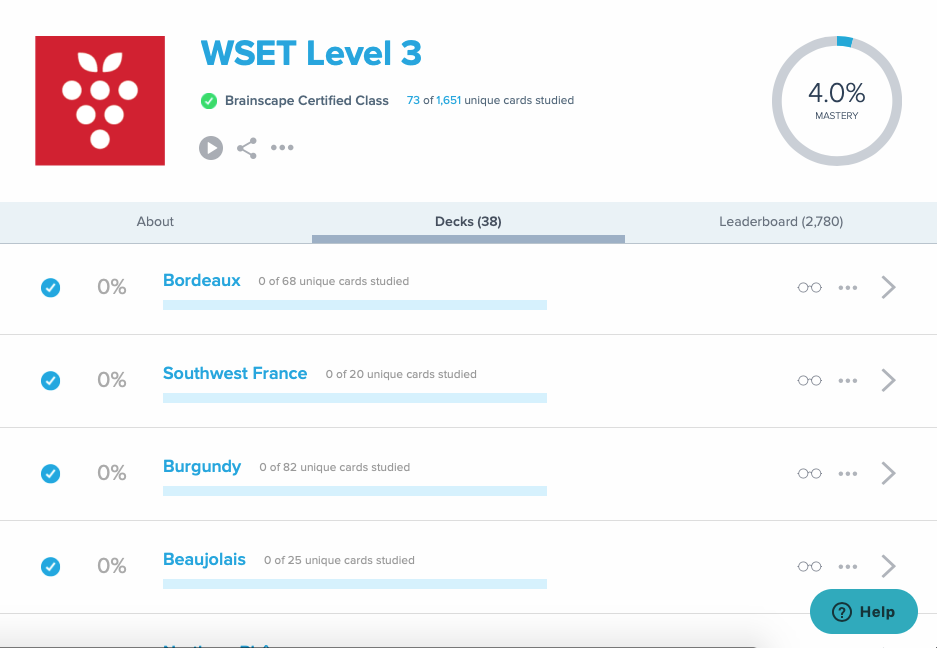
Tip 6: Know what is being asked of you in the WSET 3 exam questions
The WSET examiners want you to demonstrate that you understand what they are asking you. And you can demonstrate your understanding by:
Identifying the ‘command’ words
Look for words like ‘analyze’, ‘describe’, ‘discuss’, ‘explain’, and ‘compare’, etc. These will tell you exactly what the examiners want from you.
Reading the questions carefully
Don’t throw away valuable marks by rushing through the questions and half answering them, or by framing your answers incorrectly (for example, discussing rather than comparing). Take your time. If you’re feeling anxious, take a moment to breathe and relax before reading a question.
Tip 7: Tasting advice

As a WSET student, you are required to learn to taste wine in a logical, systematic, and professional manner in what is called the WSET Systematic Approach to Tasting® or SAT for short.
How the heck can you study for this practical portion of the exam?
Certainly, no amount of reading will really prepare you to execute the practical challenge of analyzing a glass of wine for color, bouquet, body, balance, and quality, etc. But what you can do is equip yourself with (a) the language of wine tasting (b) a methodology for wine tasting, and (c) your WSET 3 instructors’ tasting notes.
The language of practical wine tasting
At this point in your wine career, you are very likely familiar with the various flavor and aroma descriptors for wine. You are probably also familiar with the dominant flavor and aroma characteristics of certain wines from around the world.
For example New Zealand Sauvignon Blancs tend to smell potently of grapefruit, fresh-cut grass, and tomato leaf; Bordeaux blends tend to deliver a heady blend of violets, blackcurrant, cedar, and spice; and California Chardonnays tend to smell like pineapple, papaya, and vanilla.
This really comes down to practical experience and tasting wines with people who know what they’re talking about. For a refresher course in wine tasting, check out the Systematic Approach to Tasting (SAT) deck in Brainscape’s WSET Level 3 flashcard program.
The methodology of practical wine tasting
This is the logical order of variables you assess for each wine. And it requires you to remember a handful of acronyms that describe the various components that go into the flavor and aroma of a wine:
- Primary aromas: Fruit, Floral, Herbaceous, Herbal, Spice, Other (FFHHSO)
- Secondary aromas: Yeast, Malolactic fermentation, Oak (YMO)
- Tertiary (if any) aromas: Deliberate oxidation, Fruit development for white wine, Fruit development for red wine, Bottle age for white wine, Bottle age for red wine (DFFBB)
- Flavor components: Acid, Alcohol, Body, Tannin (AABT)
Memorizing these descriptors (and the array of sub-descriptors they typically come hand-in-hand with) will equip you with a logical framework to follow when creating tasting notes for a wine.
For example you are given a wine to describe, so you start by unpacking the primary aromas and flavors you detect in the wine, following the “FFHHSO” principle”:
- F—Fruity notes: green fruit (apple, pear, gooseberry, etc.); citrus fruit (grapefruit, lemon, lime, etc.); stone fruit (nectarine, peach, apricot, etc.), etc.
- F—Floral notes (rose, geranium, citrus blossom, jasmine, violet, lavender, etc.)
- H—Herbaceous notes (green bell pepper, cut grass, tomato leaf, asparagus, black currant leaf, etc.)
- H—Herbal notes (eucalyptus, mint, medicinal, fennel, dill, lavender, etc.)
- S—Spice notes (black or white pepper, liquorice)
- O—Other notes (flint, wet stones, wet wool)
Then, repeat, concentrating on the secondary aromas (YMO) of yeast (biscuit, brioche, bread), malolactic fermentation (butter, cheese, cream), and oak (vanilla, cloves, nutmeg, etc.).
And, finally, the tertiary aromas (DFFBB), if any.
Take a sip and follow the same procedure for acid, alcohol, body, and tannin, describing how these various elements (sweetness, body, dryness, etc.) affect the palate.
Pro Tip: Every time you enjoy a bottle of wine, do the SAT to practice assessing wines in the way the WSET examiners require. You may feel a little pretentious at first—especially if you’re with friends—but with practice, the descriptors will come to you more naturally and the whole process will feel more organic.
[If you're looking for more, we have a whole list of awesome wine tasting tips for the WSET Level 3 exam.]
If your friends make you feel silly for showcasing your passion, perhaps it’s time to get some new friends.
Pay attention to your WSET 3 instructors’ tasting notes
Take note of how your instructors taste and their tasting notes for the wines you sample during the practical component of the WSET Level 3. This is because he or she (or they) will likely be grading the practical component of the exam. So if you appeal to their preferred language and palate, you’ll be positioning yourself to get higher marks.
For example if you notice your instructor likes to use specific descriptors —“Mm, ah yes, forest floor with just a hint of pencil shavings”—or has a palate that’s a touch more sensitive to alcohol, use that to your advantage in the exam.
Tip 8: Group together similar wine taste descriptors

There is a crafty way you can potentially squeeze a few extra marks out when asked to write down the various descriptors for a wine’s aroma and flavor profiles.
For example you take a whiff of a Sauvignon Blanc and right away identify lemon. That’s a great start: write it down. But now, ALSO write down any other closely related descriptor you can think of, like lemon oil, lemon peel, lemongrass, preserved lemon, and Meyer lemon. Doing this squeezes extra juice out of the initial “lemon” descriptor, possibly even scoring you an extra mark or two.
Take it a step further: does it smell strictly like lemon or are there any other citrus notes you can detect? For example, lemon and lime are closely related so you can safely assume that if a wine smells like one, you can write down the other. Then, do the same for lime: lime pulp, lime zest, and so on.
The same applies for apple and pear, which are so closely related, you’re leaving points on the table if you mention one but not the other.
Once you’re done with the fruit, move on to the flowers. Does it smell like pink flowers? Then write down at least three pink flowers (pink rose, carnation, and peony). Or does it smell like yellow flowers (honeysuckle, buttercup, dandelion, daffodil, or even chamomile)? Even think of altitude: alpine (cool, crisp) versus valley floor (warm, floral).
Pro Tasting Tip: Every wine has a ‘blossom’ note in it. Figure out which color ‘blossom’ it is (pink, white, yellow) and spin it out from there!
You can use Brainscape to create flashcards for major descriptors (lemon and lime) along with their collection of sub-descriptors (lemon oil, lemon peel, lemon grass, lime pulp, lime zest, etc.)
Your logical approach to studying for the WSET Level 3 exam

The final component of our guide on how to study for the WSET Level 3 exam more efficiently is knowing the best order in which to attack your study material.
Where’s the best place to start? The answer is undoubtedly and unreservedly climate and viticulture ...
First: Climate and viticulture
Check out Brainscape’s WSET 3 flashcard decks for Viticulture and Climate .
There’s an adage that says: wines are made in the vineyards. This is a nod to the keen influence climate, geography, soil, and weather (all wrapped up in the term terroir) has on the kind and quality of grapes produced in a vineyard. And, therefore, the kind and quality of wines produced by that vineyard.
So, the best and most logical place to start is with a solid foundation in climate and viticulture. If you don’t get these fundamental sections down, nothing will make sense later.
- Get to know the different regions’ climates and weather threats (frost, hail, excessive heat, etc.)
- Understand where a region is in relation to the equator, mountains, and/or major bodies of water.
- Think of the above in the context of the different grape varieties and why some grow better than others, paying attention to each region’s climate and soils.
- Also, understand how terroir affects wine and why the same grapes grown in different places can create wines with a totally different flavor and aroma profiles.
If you understand climate and viticulture, everything else will fall into place. You’ll understand why Merlot grows so well on the Right Bank of Bordeaux (and what it tastes like) and why Merlot grown in Napa Valley tastes so different.
Pro Tip: Use detailed topographical maps to study these different regions, the mountains that dominate their landscapes, the location and proximity of major bodies of water, the layout of their farmlands and vineyards, and their neighboring countries. This might sound perfectly logical but surprisingly few WSET 3 students refer to maps when learning. Maps will give you “the big picture”—the context that will help you remember everything—and they demonstrate how everything is connected.
To do this, search for your chosen region in Google Maps and activate the “terrain” filter (top left-hand drop-down menu) and then zoom in and explore!
Second: Winemaking, maturation, and wine law
Check out Brainscape’s WSET 3 flashcard decks for the Vinification of White Wine, the Vinification of Red and Rosé Wine, and Wine, Law and Costs.
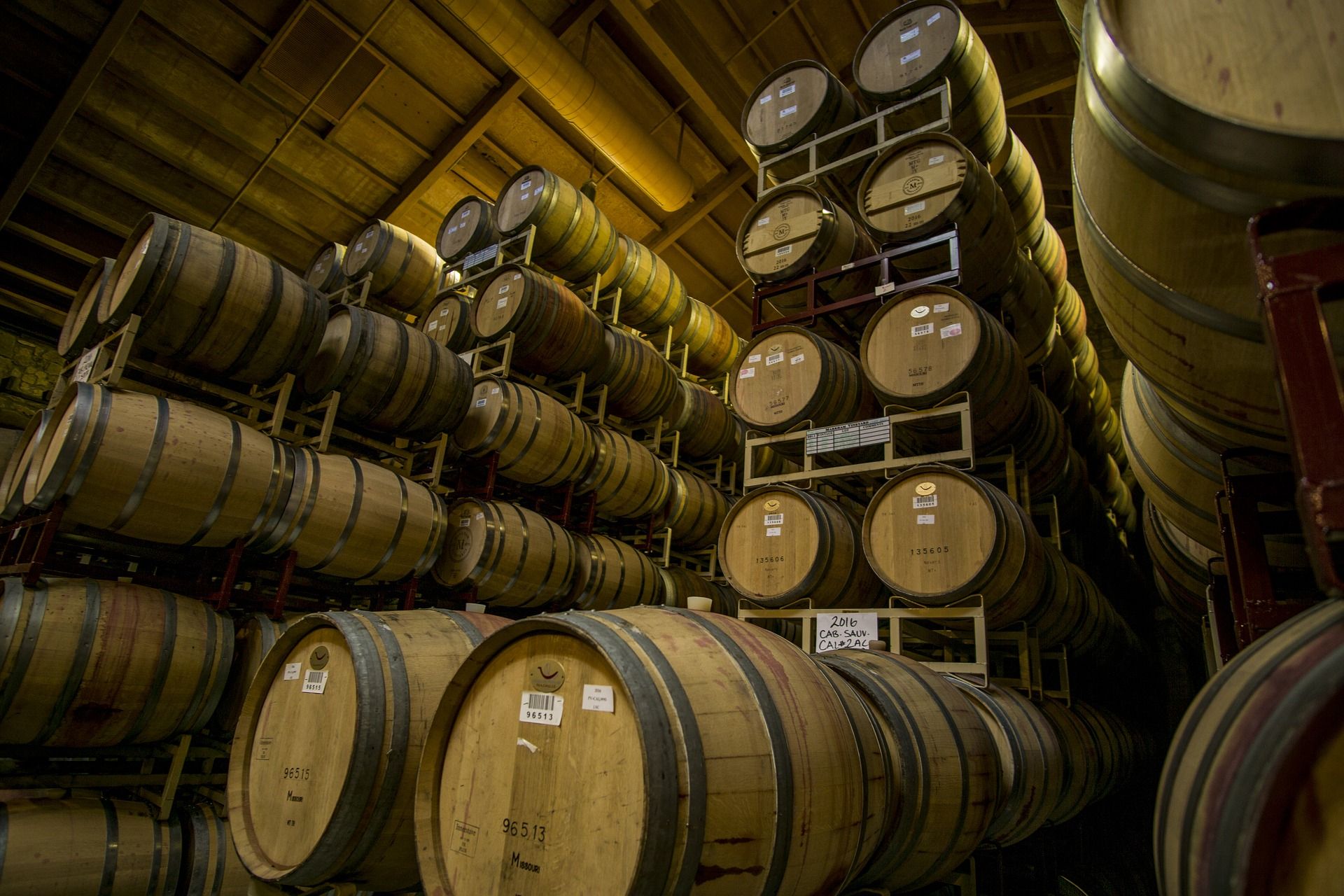
With a solid foundation in climate and viticulture, you can now dig into winemaking, maturation, and a bit of wine law. This section lays the groundwork—the essential logical framework and big-picture information—for the following section on regions and styles.
For example, it’s only logical that you learn about the vinification of red, white, and rosé wines before you dig into what makes red, white, and rosé wines from South Africa so different to those from Australia. This same education will enable you to discuss and explain the similarities and differences between Chianti Classico and Brunello. Or Brunello and Nebbiolo. Or red Burgundy and California Pinot Noir.
Third: Regions and styles
Check out Brainscape’s WSET 3 flashcard decks for Bordeaux, Germany, Portugal, South Africa, and more!
Now you’re ready for your regions and styles. This section will feel perfectly straightforward once you have that all-important foundation in climate, viticulture, winemaking, and wine law. Just remember to always keep climate in the back of your mind. Terroir is the beating heart and soul of every wine so if you have this as the backbone to your logic, the individual wine regions will come into much greater focus, rather than all blending into one another.
Fourth: Sparkling and fortified wines
Check out Brainscape’s WSET 3 flashcard decks for Champagne / Sparkling wines, Port, Sherry, and Fortified Muscats and Other Dessert Wines.

The next two topics are huge—sparkling wines and fortified wines—but, of course, they’re not insurmountable.
The most important aspects to pay attention to in sparkling wines are the production methods and the STEPS taken to make that style of wine.
Nail down the steps to making Champagne, for example, and why wines made in this style taste like they do (i.e. freakin’ delicious). Do the same for Prosecco, Moscato d’Asti, Méthode Cap Classique, etc., also being able to draw comparisons between them.
With fortified wines, the key is knowing WHEN the wine is fortified. Is it during fermentation (in order to kill off the yeast and halt fermentation), as is the case with Port? Or is it after fermentation, as is the case with Sherry? When a wine is fortified is one of the main reasons why it looks and tastes different.
Different styles of fortified wines are also made from different grapes grown on different soils, but you’ve already studied viticulture, climate, and the different winemaking regions so this information will come a lot easier to you.
Approaching the coursework in this order is a far more efficient way to study for the WSET Level 3 exam.
Also, DEFINITELY check out our article 'How to answer WSET short-answer questions' to learn the best strategy of attack for this notoriously tricky section!
A final word on the WSET Level 3 wine exam
Throughout this WSET level 3 study guide, we’ve emphasized that the WSET 3 is a knowledge-intensive examination that requires you to memorize and internalize hoards upon hoards of facts. The two keys for studying for the WSET 3 effectively and efficiently are:
- Start studying from day one of your course.
- Use Brainscape’s WSET Level 3 flashcards to help you study
That's the best way to study for WSET 3.
Our web and mobile learning platform has been specifically designed to help you learn so much more efficiently and in a way that is convenient and effective for memorizing large volumes of information.
Studying for the WSET 3 will very likely consume your free time for several months before you sit for the exam. You’ll talk about it with friends, ask your partner to test you with flashcards, and blind taste every bottle of wine that arrives on your dinner table or passes the threshold of your home.
It will become a delicious obsession. And if you are a true wine lover, it will set your soul on fire.
Don't miss our other WSET Level 3 study guides:
- What are the exam topics on the WSET Level 3?
- Wine tasting tips for the WSET Level 3 exam
- How to answer WSET short-answer questions
- How to take a WSET Level 3 practice test
P.S. When you're ready to take your next step to WSET Diploma, we have expert-curated flashcards and study guides for all five modules!
*Disclaimer: Brainscape has worked with top wine experts to supplement the official publications and preparation offered by WSET.
